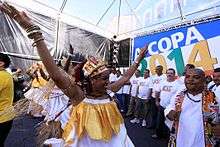Ilê Aiyê
Ilê Aiyê is a carnival block from Salvador, Bahia, Brazil. It is located in the Curuzu/Liberdade neighborhood, the largest afro-descendent population area of Salvador. The name stems from the Yoruba language: ilê - home; aiyê - life; which can be interpreted as 'eternal heaven'. It was founded in 1974 by Antônio Carlos “Vovô” and Apolônio de Jesus, making it the oldest Afro-Brazilian block.
 | |
 Ilê Aiyê performs at a pre-World Cup celebration in Salvador | |
| Nickname(s) | O mais belo dos belos (English: The most beautiful of the beautiful) |
|---|---|
| Foundation | November 11, 1974 |
| Colors | |
| Location | Curuzu Liberdade |
| President | Antonio Carlos "Vovô" dos Santos |
| Patron | Mãe Hilda Jitolu |
| 2019 presentation | |
| Title | Que bloco é esse? Eu quero saber: 45 anos de Ilê Aiyê (Which block is this? I want to know: 45 years of Ilê Aiyê) |
| Motif | Ilê Aiyê's legacy in music and Afro-Brazilian moviment[1] |
| Website | |
| ileaiyeoficial.com | |
Ilê Aiyê works to raise the consciousness of the Bahian black community. Persecuted by the police and the media during its first years, and still controversial for only allowing blacks to parade with the group, Ilê Aiyê is a renowned element of Bahia’s carnival. The group pioneered the type of carnival group known as the bloco afro, featuring themes from global black cultures and history, and celebrating the aesthetic beauty of black people. All other blocos afros borrow elements originally created by Ilê Aiyê, including such groups founded shortly afterwards, such as Olodum and Malê Debalê.[2][3]
During Bahian carnival, the group includes hundreds of musicians, dozens of dancers, and thousands of members. They traditionally begin their procession on the Saturday night of Carnaval at the home of the Dos Santos family, where for many years Mãe Hilda de Jitolu, the mother of co-founder Vovô presided as spiritual mother to the group and formal leader of a candomblé. As Ilê Aiyê passes, carnival crowds sing along by the thousands to songs about the importance of African and Afro-Brazilian culture and religion.
Discography
- 1984 - Canto Negro
- 1989 - Canto Negro II
- 1996 - Canto Negro III
- 1998 - Canto Negro IV
- 1999 - 25 Anos
- 2014 - Ilê Aiyê Bonito de se ver
References
- Osmundo de Araújo Pinho (2018-10-08). "Tema 2019 - Que bloco é esse? Eu quero saber" [2019 theme - Which block is this? I want to know] (in Portuguese). Ilê Aiye website. Retrieved 2019-04-05.
- Riserio, A, A. (1981). Carnaval Ijexá: notas sobre afoxés e blocos do novo carnaval afrobaiano [Carnaval Ijexá: notes about afoxés and blocks of the new afro-bahian carnival] (in Portuguese). Salvador: Corrupio.
- Perrone, Charles A.; Dunn, Christopher (2002). Brazilian Popular Music and Globalization. Psychology Press. p. 288. ISBN 9780415936958.